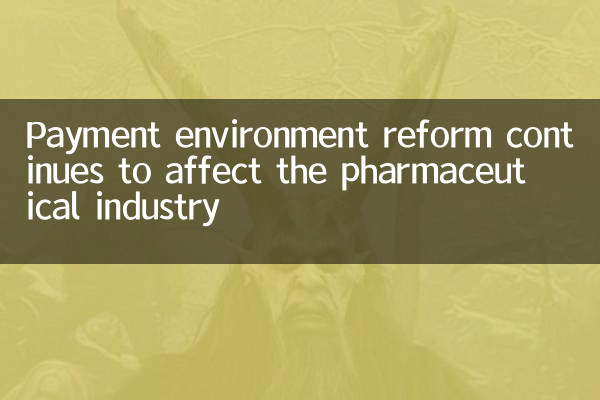Payment environment reform continues to affect the pharmaceutical industry
In recent years, with the continuous reform of the payment environment, the pharmaceutical industry is undergoing profound changes. Policies such as medical insurance cost control, volume-based procurement, and pilot DRG/DIP payment methods have been gradually implemented, which has had a profound impact on the product structure, sales model and profit level of pharmaceutical companies. This article will combine popular topics and hot topics across the network for the past 10 days to analyze the impact of payment environment reform on the pharmaceutical industry through structured data.
1. Reform of medical insurance payment methods is accelerating

According to the latest statistics, the DRG/DIP payment method reform has covered most parts of the country, and has a significant impact on hospital diagnosis and treatment behavior and pharmaceutical companies' sales strategies:
| Reform Projects | Coverage | Impact on the pharmaceutical industry |
|---|---|---|
| DRG Payment | 30 pilot cities across the country | Promote the standardization of clinical pathways and inhibit the use of high-priced drugs |
| DIP payment | 71 pilot cities | Guide hospitals to control costs and affect access to innovative drugs |
| Volume procurement | 8 batches of collective procurement have been carried out | Generic drug prices fell by 53%, forcing companies to transform |
2. Reshaping the pharmaceutical industry structure
Payment environment reform is reshaping the competitive landscape of the pharmaceutical industry, mainly showing the following characteristics:
| Business Type | Market performance | Coping strategies |
|---|---|---|
| Large pharmaceutical companies | Market share increased to 65% | Increase investment in innovation and lay out biopharmaceuticals |
| Small and medium-sized pharmaceutical companies | Reduced by 12% | Turn to specialist drugs, first-class imitation drugs |
| Multinational pharmaceutical companies | The market share of innovative drugs reaches 78% | Accelerate localization and participate in medical insurance negotiations |
3. Medical e-commerce ushers in new opportunities
With the relaxation of online payment policies for medical insurance, medical e-commerce has shown explosive growth:
| Platform Type | Growth rate in 2023 | Main features |
|---|---|---|
| B2C pharmaceutical e-commerce | 45% | The proportion of prescription drug sales increased to 32% |
| O2O medicine delivery | 68% | 30-minute delivery service covers 50 cities |
| Internet Hospital | 55% | The number of online consultations exceeded 800 million |
4. Innovative pharmaceutical companies face new challenges
Although innovative pharmaceutical companies have received policy support, they are also facing new challenges brought about by changes in the payment environment:
1.Medical insurance negotiations have significantly reduced prices: The average price reduction in medical insurance negotiations in 2023 reached 61%, and the annual treatment cost of some innovative drugs was reduced to less than 300,000 yuan.
2.Inadequate coverage of commercial insurance: Currently, the coverage rate of innovative drugs commercial insurance is only 15%, which is difficult to make up for the medical insurance payment gap.
3.It's more difficult to admit hospital: Under DRG/DIP payment, hospitals are more cautious about access to high-value innovative drugs, and 44% of innovative drugs face difficulties in admission.
5. Future development trends
Looking ahead, payment environment reform will continue to deepen, and the pharmaceutical industry will show the following development trends:
1.Value medical orientation: Drugs with accurate efficacy and high cost performance will gain greater room for development.
2.Online and offline integration: Prescription outflow has accelerated, and the off-hospital market is expected to account for 40% of drug sales in 2025.
3.Diversified payment methods: A diversified payment system combining medical insurance, commercial insurance and personal payment has gradually formed.
4.Increased industrial concentration: Industry mergers and acquisitions are accelerating, and it is expected that 30% of small and medium-sized pharmaceutical companies will be integrated in the next three years.
Payment environment reform is reconstructing the value chain of the pharmaceutical industry. Enterprises need to actively adapt to policy changes and accelerate innovation and transformation in order to win development opportunities in the transformation.

check the details

check the details